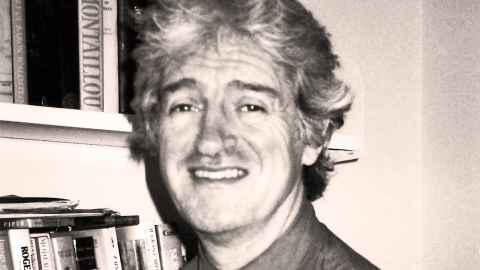Iain Bell Buchanan, 29 August 1948 – 14 November 2018
16 November 2018
An international expert in Northern Renaissance Art, Iain Buchanan had over 40 years of experience in research, teaching and publication in his field.

All of his work was based on materials he collected in European libraries and archives, and his articles and books were published by leading international journals and publishing houses.
This was no mean achievement given the difficulty of carrying out significant research in European art so distant from the main sources. There was no scholar in Australasia with a record of publication to rival his within the field.
Born in Glasgow during the years of austerity following the Second World War, he left Scotland at the end of the 1960s to study for his Bachelor of Arts with Honours in Art History at Manchester University which he completed in 1972. Moving south to Colchester, he enrolled for his Master of Arts in Aesthetics and Art Theory at the new and progressive Essex University.
On graduation, he was appointed Lecturer in Art History at the University of Auckland in 1974, quickly attracting a huge following for his courses in Renaissance Art, and on the paintings and prints of the German artist Albrecht Dürer. He also introduced a postgraduate course in Art Historiography which was greatly appreciated by students for its introduction to theoretical issues such as the problem of artistic and period style, the relations between art and society, artistic intentionality, as well as psychological approaches to art and perception through examination of texts by Heinrich Wölfflin, Alois Riegl, Aby Warburg, Erwin Panofsky and Ernst Gombrich.
His research was internationally acclaimed, and he published widely with articles on the collecting and patronage of the Netherlandish artist Pieter Bruegel as well as Dürer, and Flemish tapestry in leading periodicals such as the Burlington Magazine and the Gazette des Beaux Arts. As the recipient of a Claude McCarthy Fellowship in 1986, he visited archives in Antwerp, and reconstructed the art collection of Nicolaes Jongelinck, held at his country house, which included paintings by Bruegel and sculptures by Jacques Jongelinck.
More recently, he also investigated the Antwerp house, shop and art collection of the Antwerp print publisher, Hieronymus Cock. What was distinctive about Iain’s approach to art historical research was how he investigated the social conditions of the making of art through the reconstruction of contemporary art collections and how they were displayed.
His deep understanding of Netherlandish art enriched his undergraduate teaching where he enthralled students with vivid descriptions of the political implications of the emergence and development of the print as an independent art form in Northern Europe during the Renaissance. For the past two decades he has also been researching the collecting and patronage of tapestries by the Habsburg rulers of the Low Countries, receiving a DAAD scholarship to research tapestries belonging to Duke Albrecht of Bavaria in 1989 and a Getty Research Center Fellowship in 1994.
Tapestries were among the most expensive works of art of the period and could only be acquired by wealthy rulers such as Emperor Charles V, his aunt Margaret of Austria, his sister Mary of Hungary and his son Philip II of Spain. As rulers of the Low Countries, the main centre for the production of tapestries, the Habsburgs were extensively involved in the production and acquisition of tapestries. This has resulted in his acclaimed scholarly book Habsburg Tapestries published in Belgium in 2015, and numerous associated articles. This was the first study ever published of tapestry patronage in the sixteenth century and it has been acclaimed as a fundamental contribution to the study of the patronage of art in general.
Iain’s research was also the basis of two major exhibitions at the Metropolitan Museum in New York: one on tapestries in 2002 and Grand Design: Pieter Coecke van Aelst and Renaissance Art in 2014. He also had a special interest in Frances Hodgkins and 20th century British art, on which he has co-authored two books and several articles. At the time of his death he was working on a book which examines the paintings of Pieter Bruegel in relation to the collecting and marketing of art in sixteenth century Antwerp.
In addition to his excellence in teaching and research, his scrupulous attention to the supervision of postgraduate research, and kindly and courteous concern for his colleagues and students made him a much loved and valued member of the Faculty of Arts staff. He will be greatly missed.